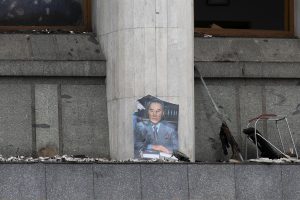One year ago, state media largely ignored the biggest outbreak of civil unrest in Kazakhstan’s history. The job of informing the public objectively about the widespread protests fell on independent reporters and a few so-called citizen journalists and bloggers who did their jobs at great personal risk. These journalists were attacked by protesters, assailed and tear-gassed by police, shot with rubber bullets, detained, and in some cases arrested, beaten, and imprisoned.
When the air, so recently filled with smoke from grenades and bullets, both rubber and real, cleared, reporters were the ones pressing the government for a full accounting of the 238 people killed, more than 4,500 injured, around 10,000 detained, and several hundred reportedly tortured.
This is the story of the Qandy Qantar — “Bloody January” — uprising through the eyes of those who covered it, beginning in Zhanaozen and ending in Almaty.
You can read this series in English at The Diplomat and in Russian and Kazakh at Orda.kz.
ALMATY, Kazakhstan: Riot police were making arrests in front of the Alatau Theater on January 4 when journalist Bek Baitas saw a protester with blood covering his face. Bek stepped closer to film. That’s when a riot officer grabbed his arm and pulled him toward a police van.
“I am a journalist,” Bek said. The 21-year-old Kazakh edition editor for Orda.kz held up his press identification and pointed to his press arm band. He hoped the police would let him go as they’d done the previous day.
Instead, the officer swore at him, punched Bek twice in the liver, and ordered him to get in the van.
The van held 10 protesters and another journalist, a former colleague of Bek’s. The two livestreamed their situation to Facebook. When they reached the police station, one of the officers twisted Bek’s hand trying to get his phone and smashed the screen.
Three people interrogated Bek for nearly an hour: “What are you doing here in the protest? What was your main purpose? Do you know the founder of DVK (Democratic Choice of Kazakhstan)? Do you love your country?”
Bek answered their questions, but added, “I am a journalist. You have no right to detain me.”
Although he knew he could ask for a lawyer, Bek said he wanted to experience what it was like to be detained and questioned. Before releasing him, police stood Bek in front of a camera and prodded him to say, “In this building I was not beaten.”
Bek’s three hours in police custody didn’t thwart his determination to cover the protests. Over the next two days, Bek found himself in the middle of a battle between protesters and police, driving on streets as people were firing guns, and following a band of marauders wielding stolen police batons.
“I could do my work from a distance, but I wanted to be in the middle of everything,” he said.
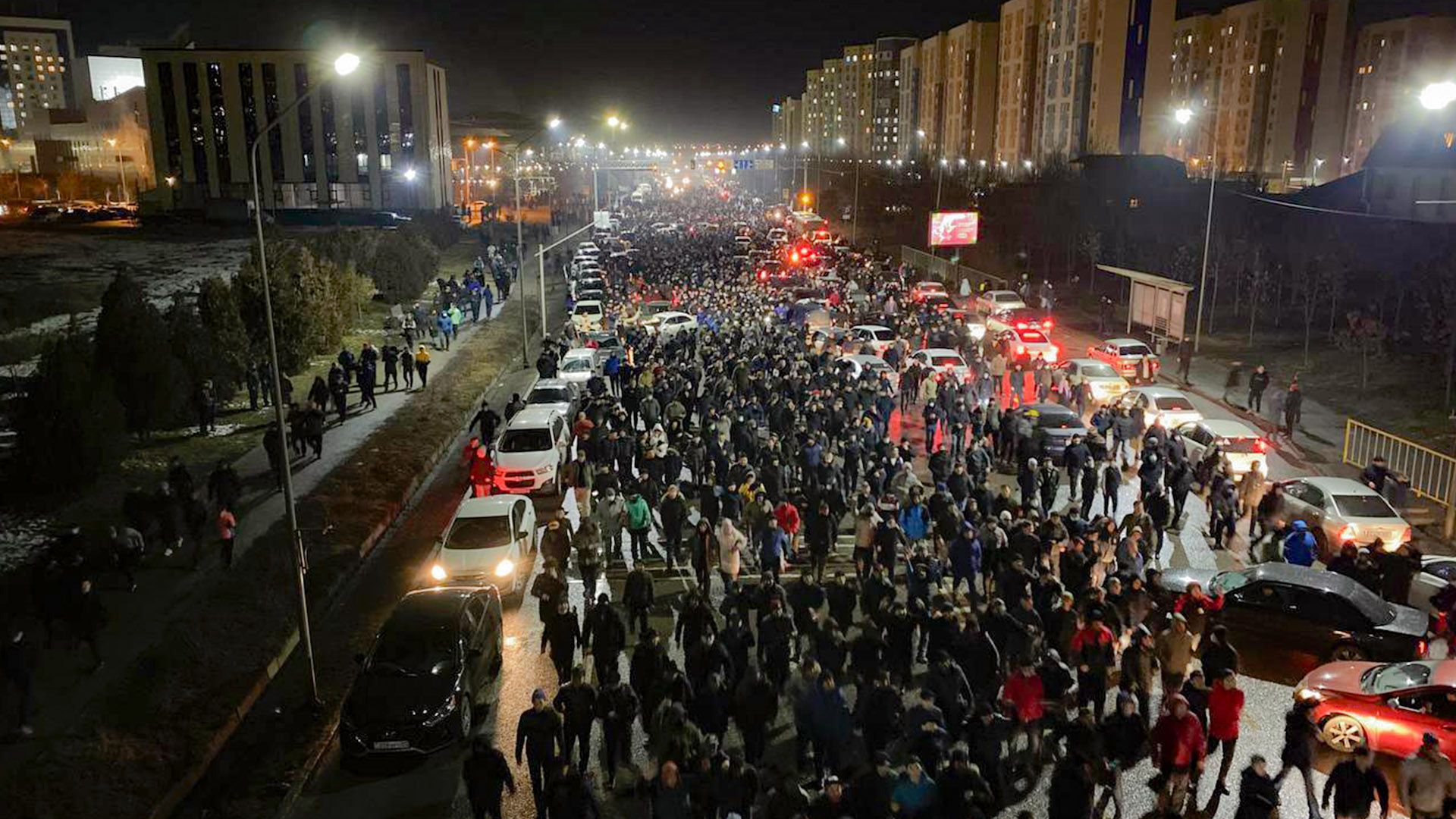
Protesters marched through the streets of Almaty, Kazakhstan’s largest city. Photo credit: Chingiz Ualikhan.
Confidence Among Protesters
Azattyq journalist Asylkhan Mamashuly, 49, arrived at the Alatau Theater about 8 p.m., just after Bek was arrested. He watched as about 300 black-clad riot police attempted to rush the theater steps where thousands of protesters stood, occasionally singing the national anthem and chanting “We support Zhanaozen!” The protesters pushed the police back several times.
When the crowd moved into the street in front of the theater, two military vehicles drove up and deposited soldiers in riot gear — helmets, shields, and batons. In response, the mostly youthful crowd rushed the soldiers, and a fierce fight ensued, Asylkhan said. Some soldiers lost their shields and fell to the ground clasping their heads in the hands. The protesters kicked them.
“This is the first time I had seen such confidence appear among protesters,” Asylkhan said. “They easily fought back.”
Protesters told Asylkhan that theirs was the third group of protesters who had broken through special forces lines and marched to the city center.
It was 3:30 a.m. when Asylkhan arrived at Almaty’s Republic Square. Soldiers had pushed protesters off the square and onto nearby streets. The air was thick with tear gas. Broken paving stones and shell casings were scattered on the square, along with traces of blood.
West of the square, armed men threw grenades with tear gas at the crowd of protesters. One of the grenades exploded near Asylkhan.
“I thought I was going to die,” said Asylkhan. “I didn’t know what it was. I felt a burning sensation in my throat, tears spilled from my eyes.” He gasped for fresh air and ran to a nearby street to get away from the gas. “It took 30 minutes before I could breathe normally.”
Asylkhan didn’t understand how the protesters on the front lines could endure breathing the gas. None of them had gas masks. By 4 a.m. protesters were reporting to Orda.kz that police were firing at them with rubber bullets. The face-off with soldiers continued until morning.
Residents in Almaty woke up to the news that overnight President Kassym-Jomart Tokayev had called for a state of emergency in the city, Kazakhstan’s largest.
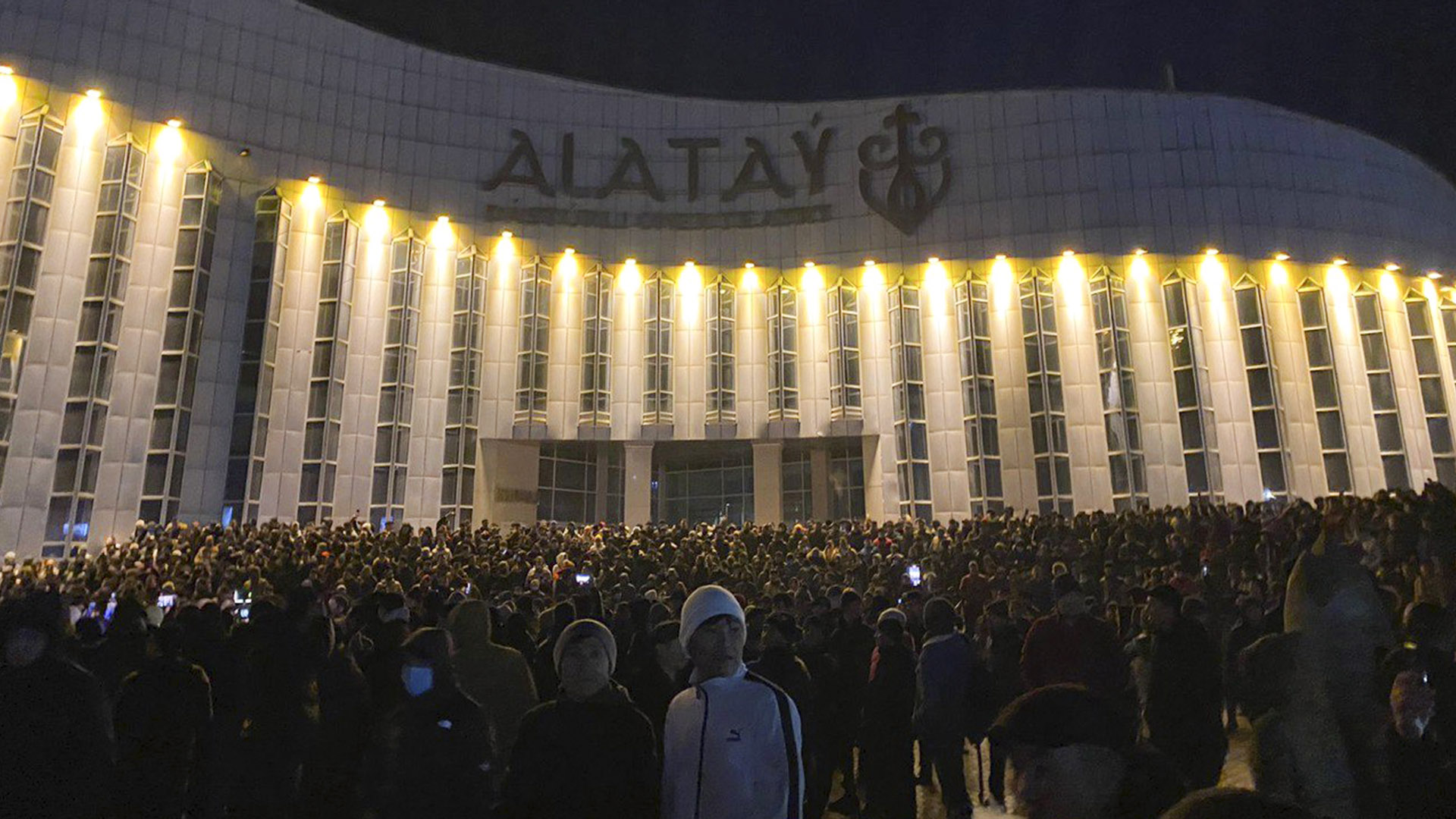
Protesters gather near the Alatau Theater in Almaty. Photo credit: Chingiz Ualikhan.
A Game of Thrones
Around 10 a.m. on January 5, Bek joined two of his Orda.kz colleagues, Leonid Raskazov, 37, a cameraman, and reporter Madina Aesheva, 25, who were filming protesters and police facing off at the intersection of Baytursyov and Karasay Batyr Streets in what Leonid called “a Game of Thrones” battle.
“They were two walls, one was protesters and the other police,” he said. To get a better angle, Leonid and Bek moved closer to the middle of the standoff.
The police were dressed in riot gear with shields and batons, Bek said. Protesters threw up their hands and called out: “Don’t shoot.”
Police fired shock grenades, tear gas, and rubber bullets. Protesters were the targets, but at least a dozen journalists were covering the battle and in the line of fire, Leonid said.
Leonid and Bek backed away as tear gas burned their eyes and irritated their throats. That’s when a rubber bullet struck Leonid in the back, staining his jacket.
“It felt like someone had kicked me,” he said.
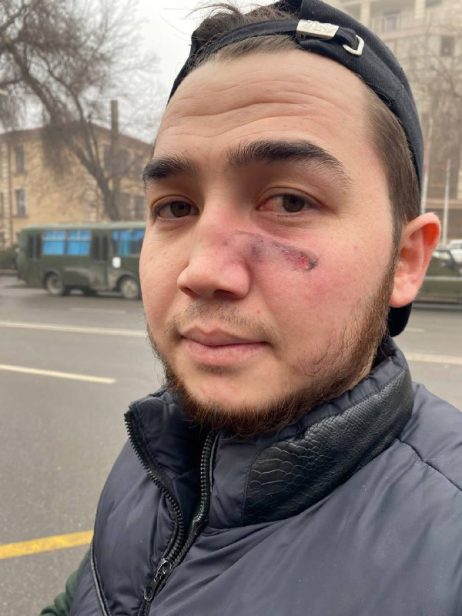
Bek Baitas, an editor for Orda.kz, was covering the protests in Almaty when a rubber bullet struck him in the face right below his eye. Photo credit: Bek Baitas.
A rubber bullet hit Bek under his eye.
“It felt like my eye was on fire.” Bek’s cheek quickly turned purple, and for the rest of the day he couldn’t see. They ran to a nearby pharmacy and got some medicine that helped with the pain, but despite their injuries, the two journalists decided to stay on the street and continue filming.
“I didn’t think it was dangerous,” Leonid said. “No one was threatening us at that point. It was a fight between police and the protesters.”
Eventually some protesters would turn on Leonid.
Shooting with Real Bullets
That same morning, Asylkhan and Azattyq cameraman Sanat Nurbek, 45, returned to the Alatau Theater where a small crowd of protesters had gathered. No police were in sight. Several protesters gave Asylkhan interviews, but many avoided Sanat’s cameras.
The crowd listed demands and was increasingly angry officials hadn’t addressed them, Sanat said. The protesters decided to take their issues directly to the police and city hall.
As Asylkhan and Sanat followed the protesters, they saw that the Nur Otan party’s building was on fire. Nur Otan (renamed Amanat months later in a rebranding exercise) is Kazakhstan’s ruling party, founded and led until late 2021 by Nursultan Nazarbayev.
When the crowd of protesters reached the police station on Tole Bi Street, they demanded that police release those who had been detained the previous night. Police refused to meet with the protesters. Officers stationed on the roof of the building carried guns and threw shock grenades at protesters to try to keep them away, Sanat and Asylkhan said.
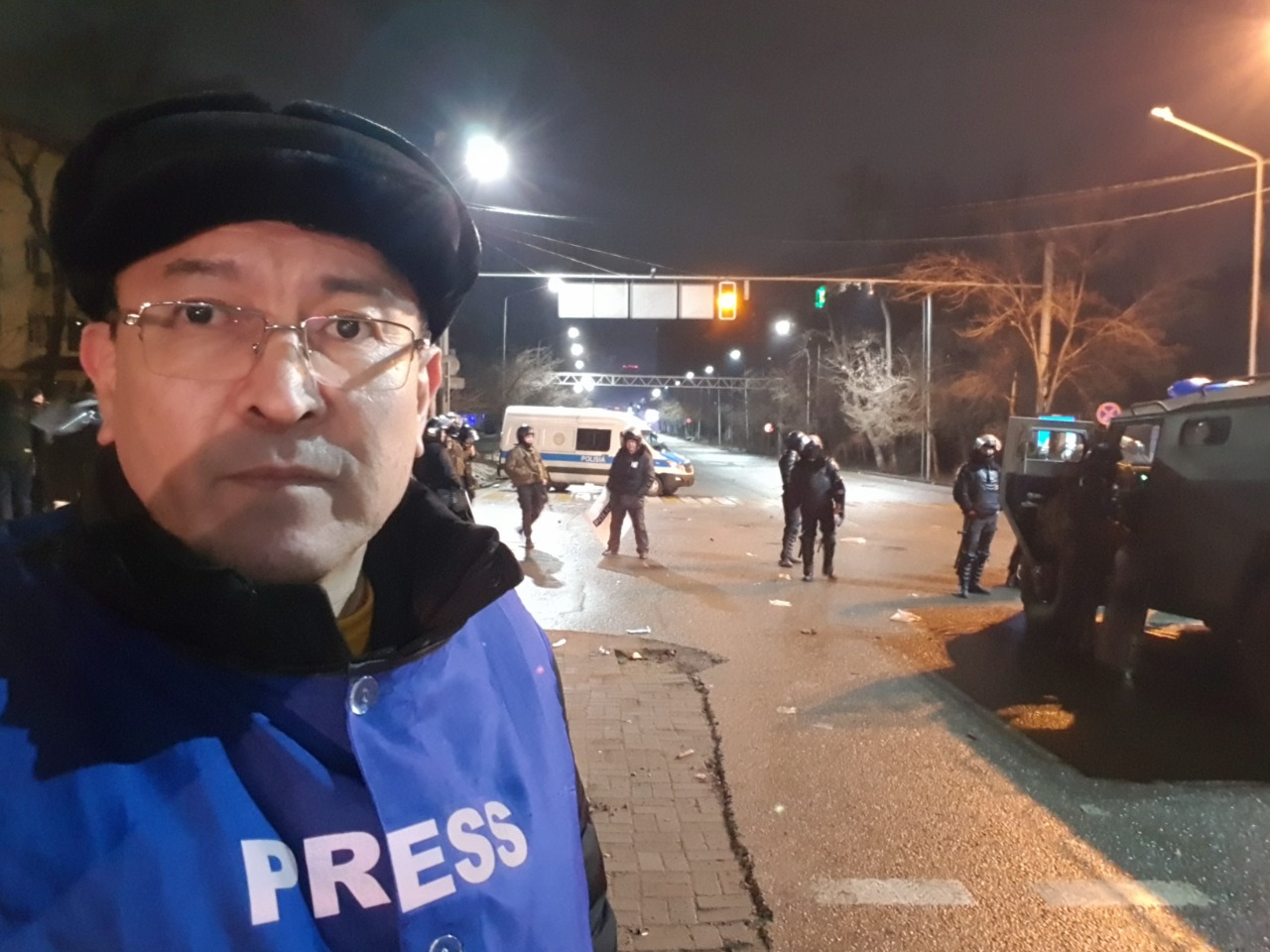
Azattyq journalist Asylkhan Mamashuly, 49, wearing his press jacket while covering the protests in Almaty in January 2022. Photo credit: Asylkhan Mamashuly.
The protesters stood outside the police department for hours, calling for someone of authority to talk with them.
About that time, Asylkhan went back to the office and reporter Ayan Kalmurat joined Sanat. Almost immediately, protesters acted aggressively toward Ayan, a new face in the crowd, Sanat said.
“I was scared,” said Ayan, 26. “They tried to beat us several times with sticks and shovels. I realized that my press jacket and camera with a microphone made them angry. They wanted to hide their faces. These people were not peaceful. Peaceful protesters, on the contrary, saved us.”
Eventually, the protesters continued to Republic Square. Ayan and Sanat followed.
Sanat noticed that many protesters were young people wearing thin clothing, not appropriate for winter. Along the way, they saw several civilian cars and military vehicles that had been burned during the clashes. When they reached the square, people were urging the crowd not to damage anything.
Meanwhile, protesters, carrying police shields, sticks, and shovels, were growing more and more agitated because no officials had addressed them.
“They were shouting their demands toward the mayor’s office,” Sanat said. “When there was no reaction from the government, they set the mayor’s building on fire.”
About half an hour later, Sanat saw that the President’s Residence also was on fire.
People were running and screaming that there was shooting at the residence, Sanat said. He and Ayan saw people who’d been shot in the legs and torso. They were lying on the ground, blood pooled around them, he said. The bullets looked like pellets from a shotgun.
Fog and low visibility added to the mass confusion. “The young people were very aggressive and ready to go into the residence and fight with the shooters,” Sanat said.
He and Ayan were interviewing injured people near the President’s Residence when two military vehicles came barreling down the driveway, the occupants shooting wildly at the crowd.
“Ayan told me to run. But I turned and filmed these two vehicles,” Sanat said.
The two journalists were separated in the chaos. Protesters were trying to enter the burning residence.
About five minutes later, Sanat got a phone call. It was Ayan. He’d run back to the office. He was afraid Sanat had been shot.
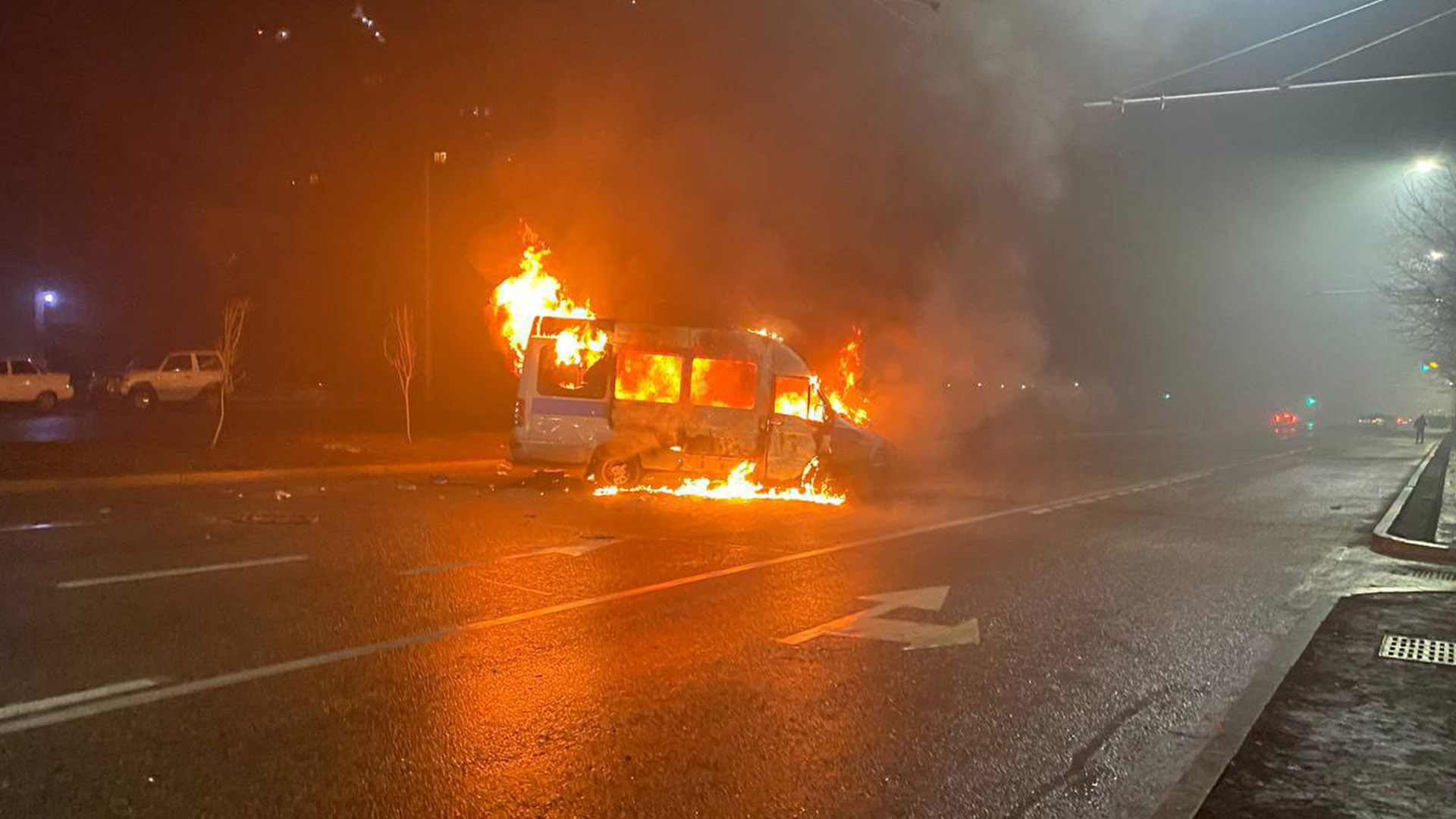
A van burns in the street in Almaty in early January 2022. Photo credit: Chingiz Ualikhan.
Ethnic Conflict
Leonid and Madina were filming near Republic Square that afternoon, too. They saw several protesters carrying rifles. At the corner of Zheltoksan and Timiryazev Streets they saw soldiers running away from city hall, chased by protesters who were carrying weapons and shovels. One soldier stopped a car, got in, and escaped. Other soldiers ran toward three police cars, but the police cars took off without them. The protesters caught up with the soldiers and beat them, Leonid said.
Then another large crowd started approaching them.
“When the police left, it became scarier,” Leonid said. “You realized you were not safe because even the government was being beaten.”
Leonid and Madina decided to move closer to city hall. But when they reached the entrance, they saw protesters had set the building on fire.
That was when the protesters turned on Leonid, who was wearing a press vest. They asked him where he was from. Leonid was born in the north of Kazakhstan and identifies as ethnic Russian. Madina, who is ethnic Kazakh, explained to them in Kazakh that they both worked for Orda.kz.
A conflict broke out between protesters over whether Leonid should be allowed to film what was happening. The protesters who acted most aggressively were afraid of the consequences, and they started pulling at Leonid’s press jacket and grabbing at his camera.
By then it was early evening. Leonid and Madina decided to return to the office. When they reached Dostyk Street, protesters tried to rip off Leonid’s press vest again. They took his camera. They spit on him. They cursed at him for being Russian and were angry that more Russians were not protesting.
“It was the first time in my life when people started to scream things about my nationality,” he said. “They were swearing, using bad words.” Leonid pulled his hood over his head and wore a medical mask on his face as he tried to ignore the protesters.
“I was offended. Kazakhstan is my homeland,” he said.
Madina appealed to another group of protesters to help. They managed to get Leonid’s camera back. Then several protesters encircled Madina and Leonid, shielding Leonid as he took off his press vest and hid his camera.
“Now I feel I am not in my country,” Leonid said.
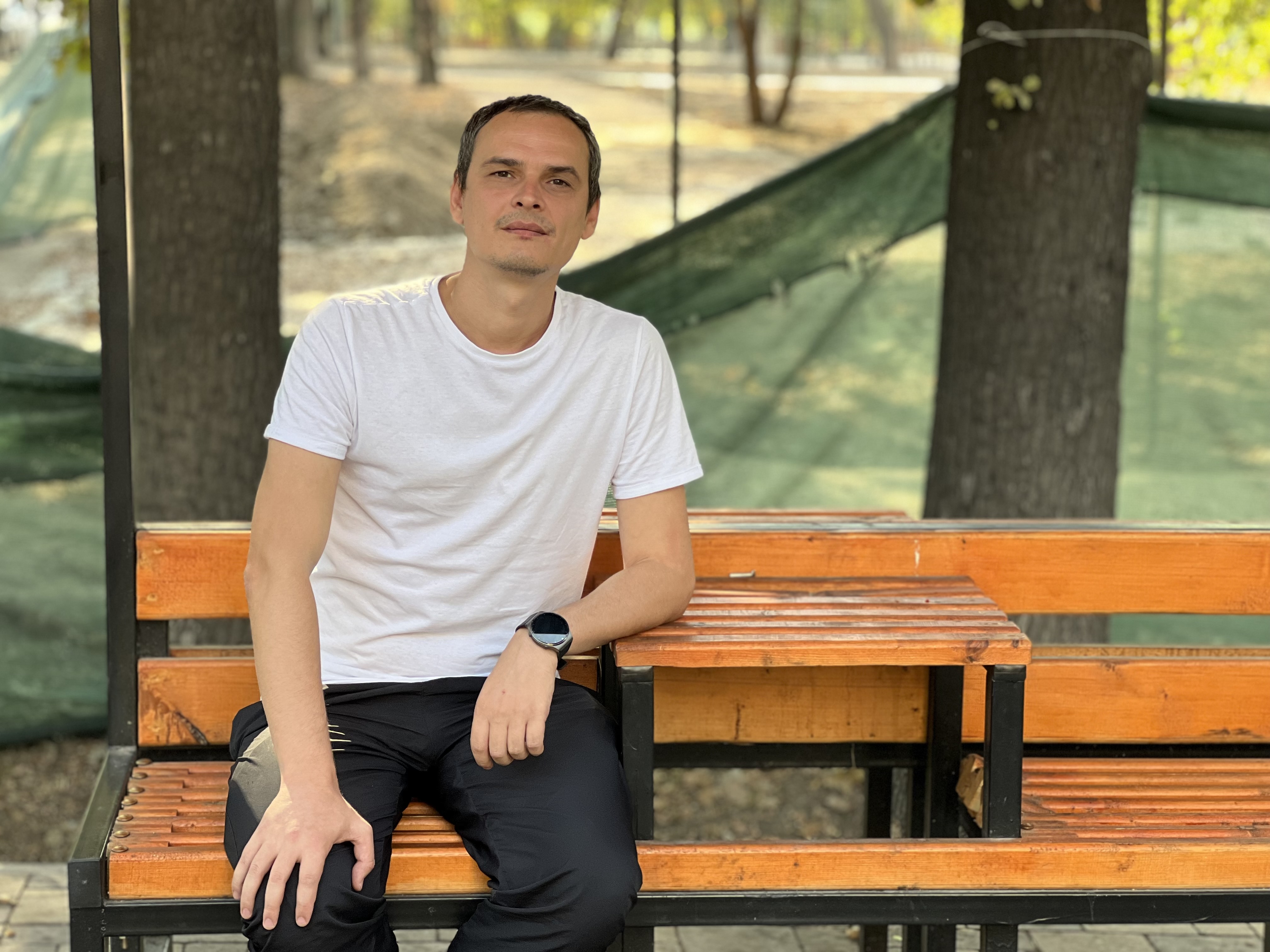
Cameraman Leonid Raskazov was born in the north of Kazakhstan. Photo credit: Cheryl L. Reed.
Too Dangerous
After Sanat and Ayan were shot at, Kassym Amanzhol, Almaty bureau chief for RFE/RL’s Radio Azattyq, recalled all reporters from areas where there was shooting because the situation was too dangerous. Protesters set fire to two buildings where state-funded media stations Kazakhstan, Khabar, First Channel Evrazia, KTK, and Mir 24 were located.
“Protesters deliberately went to these TV stations and set them on fire,” Kassym said. “They did it because they were angry that they have been fed the wrong information all these years. I am proud to say that when people in the protest saw that our reporters were from Azattyq, they circled around them so that no harm would happen to them.”
Kassym had also been detained for two hours by police the previous evening covering a protest on the east side of town.
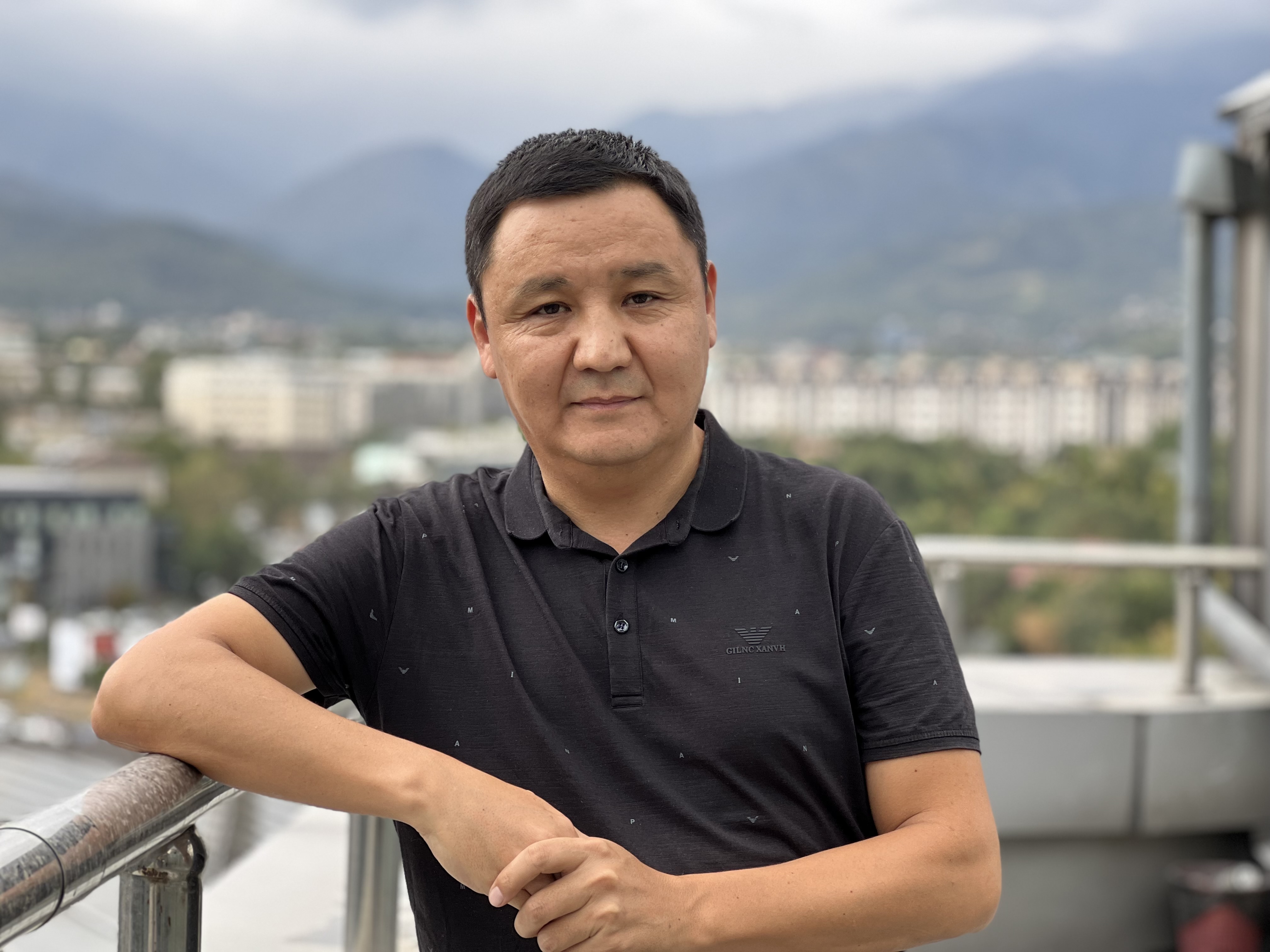
Kassym Amanzhol is the Almaty bureau chief for RFE/RL’s Radio Azattyq. Photo credit: Cheryl L. Reed.
His colleague, Darkhan Omirbek, editor of Radio Azattyq’s office in the Kazakh capital, was also arrested on January 4 while covering a protest despite holding up his press identification. He was among about 100 protesters detained.
“They asked me to sign a paper saying that I regretted going to the protest, and I wouldn’t do it,” he said. He was held for four hours and released without charges.
In Nur-Sultan (months later renamed again as Astana), where protests were sporadic and non-violent, Darkhan said many protesters he encountered were drunk. “Going against authority is a big deal in our culture, and some of them needed alcohol to give them courage.”
After his release, Darkhan began building a Google spreadsheet with the names of those who were killed during the protest. “I started it to get some kind of order to the instant reports of death,” he said. After it was first published in late January, it quickly became the country’s most reliable list of the dead. The government was slow to give names of the deceased and warned families that if they provided information about their loved ones’ deaths, mistreatment, or torture, that those victims would be labeled terrorists, Darkhan said.
Gulnara Bazhkenova, chief editor and part-owner of Orda.kz, said that after Bek and Leonid were shot with rubber bullets on January 5, she ordered reporters to stay at the office. “If I sent somebody and something happened to them it would have been my responsibility,” she said.
“Several didn’t listen,” Gulnara added. “Thanks to God, we are all alive.”
Gulnara chose to put herself in danger. She put on her press vest, rented a car, and with her assistant editors filmed what they witnessed on the streets.
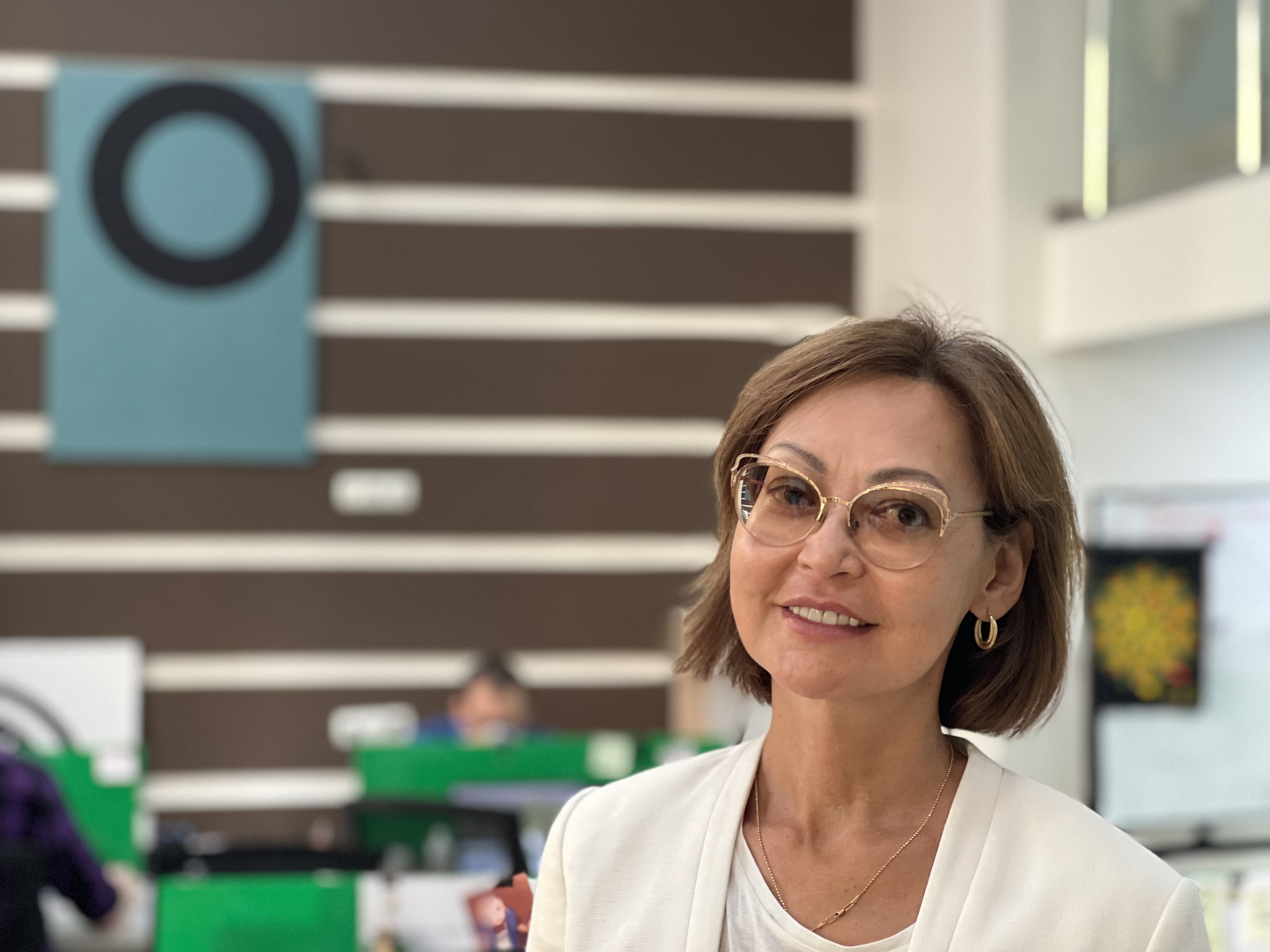
Gulnara Bazhkenova is chief editor and part-owner of Orda.kz. Photo credit: Cheryl L. Reed.
Despite the internet being shut down, editors in the Orda.kz office discovered that two laptops somehow maintained a connection, and through them, they were able to post a constant stream of news updates to their Telegram channel.
Two journalists, whom Gulnara described as “afraid and uncomfortable,” quit Orda.kz during the protest. “I say if you are afraid, you shouldn’t be a journalist.”
Muratkhan Bazarbayev, who worked for Almaty TV as a driver, died when gunmen opened fire on two vehicles carrying the city mayor and an Almaty TV camera crew to city hall. Bazarbayev suffered gunshot wounds to the stomach and legs and died at the scene. A cameraman for Almaty TV was also shot in the hand and later had two fingers amputated.
Drunk and Aggressive
By the evening of January 5, clashes between police and protesters were growing increasingly violent. Loudspeakers in the city center urged residents to stay off the streets. Groups of protesters had shut down the Almaty airport, seized five planes, and killed two soldiers. Some had also captured government firearms and stormed gun shops.
This didn’t deter Bek from driving around the city. He spotted a dead body on the street near the corner of Manshuk Mametova Street and Seyfullin Avenue. But when he got out of his car and approached, a crowd of people aggressively warned him to go away.
Back in his car, as he was turning from Seyfullin to Tole Bi Street, a driver pulled up beside him, rolled down his window, and held out a rifle. He warned Bek, “I’m going to shoot.” Then the man fired in the air.
Later that night, Bek heard shots fired toward his car near the police station on Tole Bi. He would later learn that a 12-year-old boy was killed in the area at that time.
Bek saw looters moving in and out of cafes, banks, offices, and shopping centers, stealing whatever they could find, including ATM machines.
By 9 p.m. Bek said he no longer saw any police in the city. People were jumping on top of police cars. They were running through the streets with stolen police shields. He saw cars on fire, including a firefighter vehicle, three police cars, and several civilian cars.
Many people were driving cars without license plates, apparently to avoid being caught on surveillance footage.
That night Bek decided he was safer not wearing his press armband.
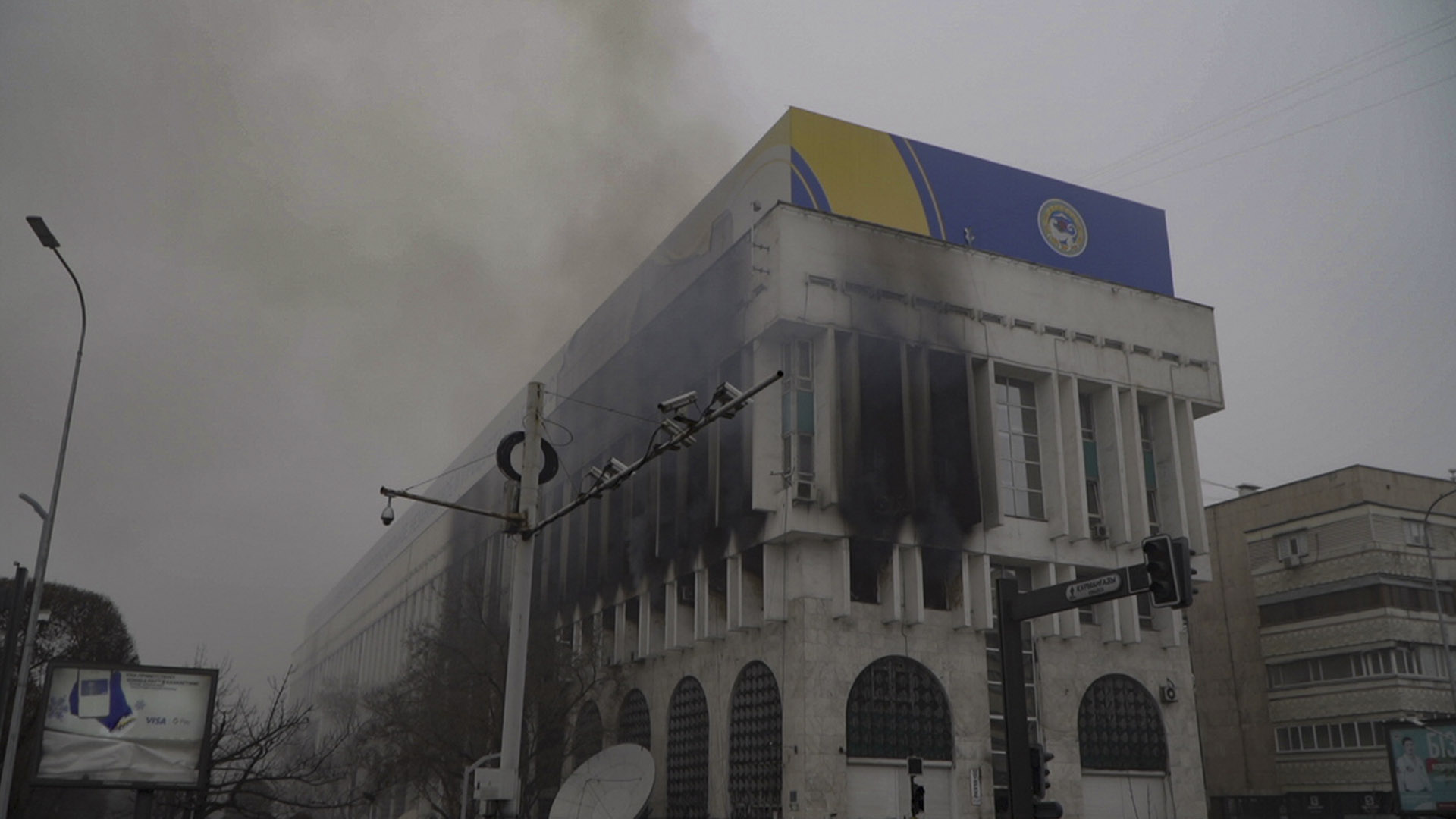
A building smolders in Almaty in early January 2022. Photo credit: Leonid Rasskazov.
“We Are Not Terrorists!”
On the morning of January 6, 3,000 Russian paratroopers arrived in Kazakhstan, responding to Tokayev’s formal request for assistance from the Collective Security Treaty Organization (CSTO).
That morning, Bek went back to Republic Square. City hall and the President’s Residence were still smoldering. He saw spent shell casings on the ground. He hadn’t slept much; his face was swollen, his cheek still purple from where the rubber bullet had struck him the day before. He met a group of drunken marauders who mistakenly thought he was part of their group, dressed plainly as he was in sweatpants and a hat.
The marauders told him their plans to build a barricade on Republic Square. They pointed out the blood stains on the square and claimed they wanted to search for bodies so they could return them to their relatives.
Bek said he didn’t tell them he was a journalist, and he didn’t film while he was with the group. They offered him a police baton for his own protection, but he said he declined it. The majority of the group was drunk and aggressive.
“I was a little bit scared. But my interest and excitement toward my work didn’t let me go home,” he said.
That afternoon, about 300 people gathered on the square. Several held up a long banner on a white cloth, which said in large letters: “We are ordinary people! We are not terrorists!”
In the evening, people in military uniform opened fire on protesters gathered in the square, killing dozens.
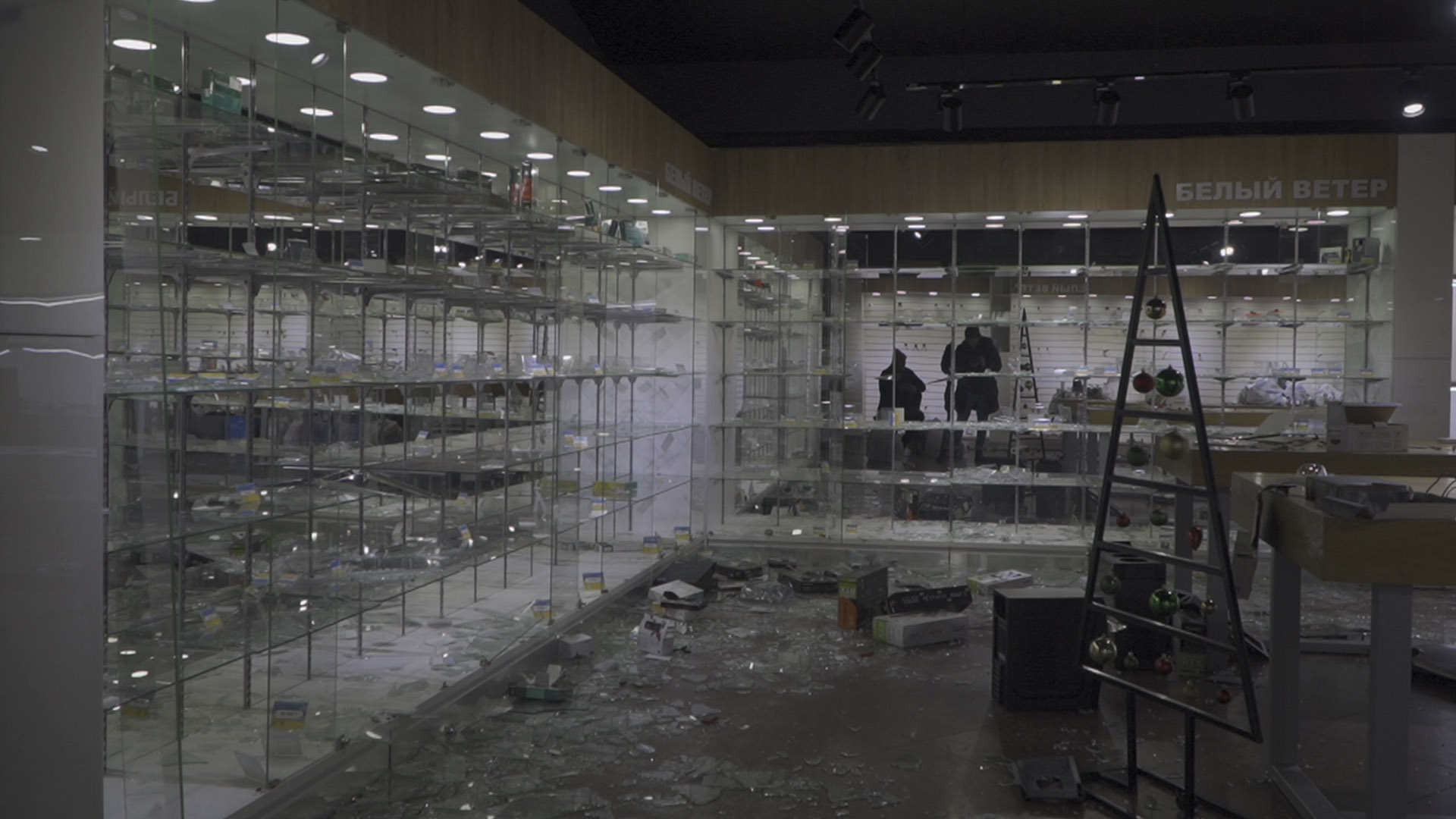
A store in Almaty smashed and looted amid the protests in January 2022. Photo credit: Leonid Rasskazov.
Gasoline Looters
On January 7, Asylkhan rode around the city with two reporters from Moscow. They drove by Republic Square and the President’s Residence, but they didn’t get out because the military was shooting from the buildings.
“We couldn’t ask why and who they were shooting at,” Asylkhan said.
Near the square they saw a car with five or six bullet holes in the windshield and blood stains on the passenger seat.
On the radio, the government warned that an anti-terrorist operation was underway. Tokayev had granted law enforcement authority to shoot protesters without warning.
West of downtown, Asylkhan saw people at gas stations collecting fuel in buckets. Nearby several men doused passing cars with gasoline and set them on fire.
Asylkhan said he and the Moscow reporters gathered a bunch of men together and drove the fire starters away.
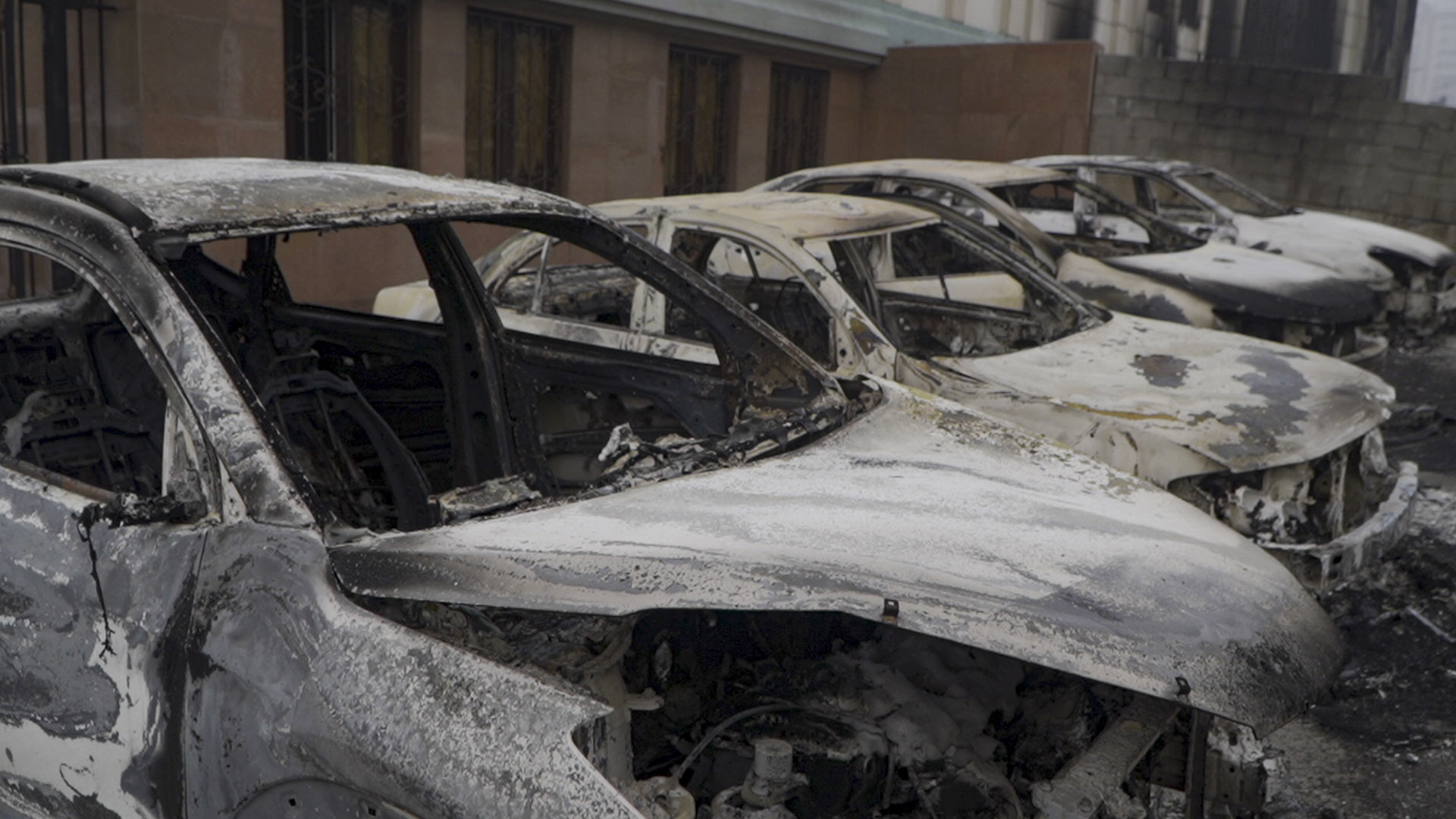
Burned cars in Almaty. Photo credit: Leonid Rasskazov.
Death in January
That same day, Bek received a call from his parents. His grandmother had died.
“I didn’t feel any pain,” he said. “I couldn’t even cry.”
By then he’d seen several victims of Bloody January lying dead on the streets of Almaty. He’d seen so many ugly things he was numb.
His grandmother was buried the next day, but Bek couldn’t make it home for the funeral. Seven days later, he set out for his family’s village to pay his respects. As he made the three-hour drive, he realized he had come close to death four times while covering the protests and, at last, he cried.
“I realized I did everything wrong and there was no necessity for me to have risked my life,” he said. “Getting good material is not worth my life.” He stopped and thought for a moment. “The best success is to stay alive and continue working.”
More than 50 violations against journalists’ and bloggers’ safety were recorded in connection with the coverage of the January protests, according to Adil Soz, an Almaty-based media advocacy group. At least 22 journalists were detained and questioned during the seven days of protests in Kazakhstan or immediately after, including five who were imprisoned and five who say they were beaten.
According to official figures, which were finally released in August 2022, 238 people died in that first week of January. Nearly 10,000 people were detained and questioned during and in the weeks following the protests. Kazakhstan courts convicted 1,113 people, nearly half on charges of “participating in mass riots.”













